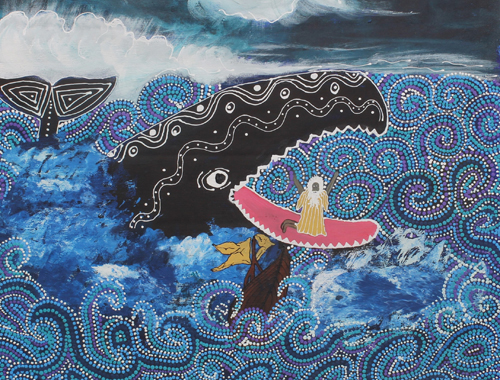
DAVID ADAMS reports on the creation of a new book, Our Mob, God’s Story, showcasing the work of Indigenous Australian artists to mark the bicentenary of Bible Society Australia…
When Indigenous artist Safina Stewart was approached about contributing to a new book, Our Mob, God’s Story, in which Aboriginal and Torres Strait Islander artists were asked to depict stories from the Bible as part of efforts to mark Bible Society Australia’s (BSA) bicentenary, she saw it as a chance to “return the generosity” of the BSA toward her.
Ms Stewart recounts how in 2015, she was given a Bible in the Yumplatok language at a coming together of Christian leaders, known as the Grasstree Gathering, from across the country.
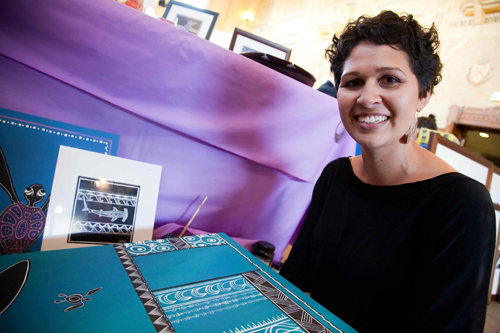
Indigenous artist Safina Stewart says she took part in the book “in the hope that many more people would benefit from seeing God’s imprint in our black fella culture and for the Spirit to move through the common language of the arts.”
“Bible Society Australia is always keen to showcase the way the Bible has influenced people, the effect that God’s Word has on a person’s life and this was an opportunity to do just that. Art has a way of speaking to us in a very different way than the written word, it is a universal language and it is a way to reflect on many well known Bible Stories and see them in a whole new light.”
– Louise Sherman
“Their gift has enabled my fellow Grasstree participants and I to take the Bible back to our Aboriginal and Torres Strait communities to share God’s story in our own language and in our own style,” she says.
“It has been through the Yumplatok…translation that I have been relearning my lost language and building trust in Jesus. Now my faith enhances my culture, and my culture enhances my faith. It has been profound to have a Bible in my own language. There are not the right English words to properly express how profound.”
She says that one of her “greatest joys” has been being invited to read the Yumplatok translation to the congregation at her majority white people church and then explain its cultural significance and meaning.
“The connections went off like fireworks,” she says. “My non-Indigenous brothers and sisters got blessed too. So when the Bible Society approached me and my fellow Aboriginal and Torres Strait Islander Christian artists to submit work for this publication, naturally I wanted to return the generosity in the hope that many more people would benefit from seeing God’s imprint in our black fella culture and for the Spirit to move through the common language of the arts.”
The book, only just released, features more than 115 paintings by 67 different artists. As well as chronologically presenting stories from the Bible, it also tells some of the artists’ personal stories of faith.
The idea for the project came from Glenn Goodwin, an accountant from Moree in New South Wales, who first approached Bible Society Australia in 2010 about funding a book that would not only proclaim the Gospel but also benefit Aboriginal and Torres Strait Islanders.
A committee was put together and work on the book started in 2012 with the idea, according to the book’s co-editor, Louise Sherman, of producing “a high quality coffee table art book which will showcase paintings as well as giving the artists the opportunity to share their faith story”.
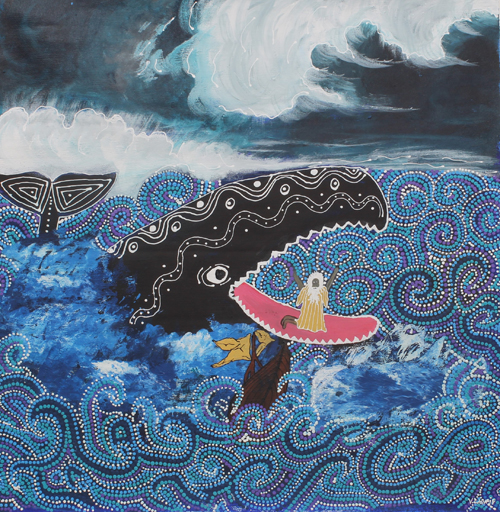
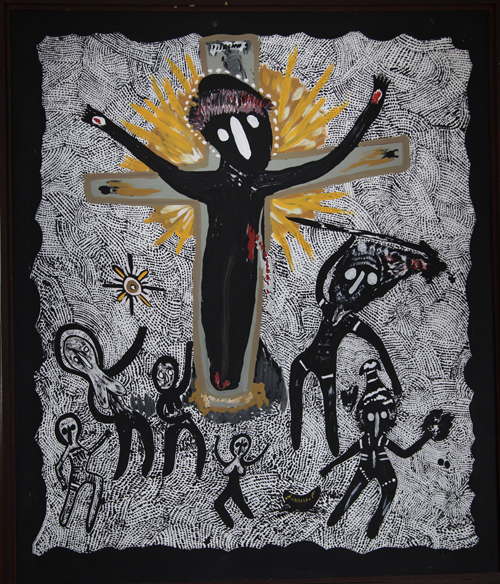
OLD AND NEW TESTAMENT: ‘Jonah and the Whale’ by Verna Lawrie and ‘Calvary’, part of the ‘Life of Jesus’ series by Ellen Draper – two of the artworks featured in the book. PICTURE: Supplied.
Ms Sherman, who works in Bible Society Australia’s national missions portfolio, says the resultant work, as well as clearly presenting the stories of the Bible, showcases the “talent and diversity” of Indigenous artists and provides an opportunity to educate the wider community about the diversity of Indigenous culture and languages. In addition, she notes: “All funds raised through the sale of the art book will go directly towards Indigenous Scripture publication and ministry support work.”
The sourcing of the artwork took four years and followed a call for submissions made by Bible Society Australia through various art centres and galleries across Australia as well as via the organisation’s mission partners, Indigenous translators and churches. More than 350 pieces of artwork were submitted and a selection committee, comprised of Aboriginal and Torres Strait Islander artists, selected the artwork for inclusion based on criteria which included that it portrayed a Biblical story or theme, the work was of a high quality and that the artists came from a range of different locations – those behind the project wanted to ensure a representation of different styles of Indigenous art from across Australia.
“We really wanted to show that Aboriginal and Torres Strait Islander art is more than just dot paintings and that different language groups and regions use different styles and imagery in their art,” says Ms Sherman.
“We have monochrome lino print work from the Torres Strait, Wadjina imagery from Western Australia, X-ray style painting from Arnhem Land and Central Desert Warlpiri iconography just to name a few of the styles contained in the book. In fact there are several pieces of artwork which portray the same Bible story but are painted in completely different styles and it is fascinating to see how the different Indigenous cultures and languages affect the way the story is told through art.”
Ms Sherman says the book taps into the ability of Aboriginal and Torres Strait Islander artists “to use art to tell a story and use unique symbolism to share their faith”.
“Bible Society Australia is always keen to showcase the way the Bible has influenced people, the effect that God’s Word has on a person’s life and this was an opportunity to do just that. Art has a way of speaking to us in a very different way than the written word, it is a universal language and it is a way to reflect on many well known Bible Stories and see them in a whole new light.”
Co-editor, award-winning author Christobel Mattingley, has worked with Ms Sherman on the book for the past five years, having already worked with Aboriginal people on four books as part of her decades long association with Indigenous communities.
She notes that as well as sharing Bible stories (which it does chronologically), the book is also about sharing the stories of Aboriginal and Torres Strait Islander people, describing it as an “outreach to gain more respect for Aboriginal people and their talents”.
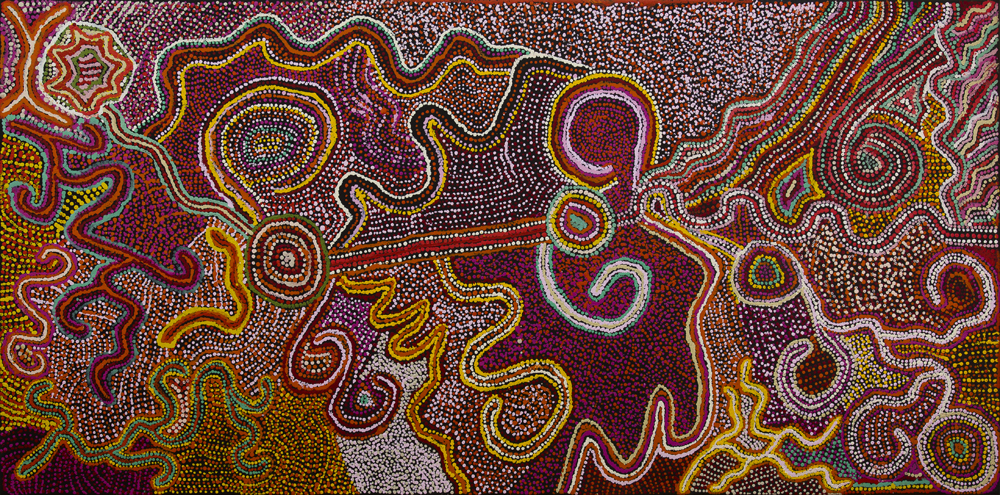
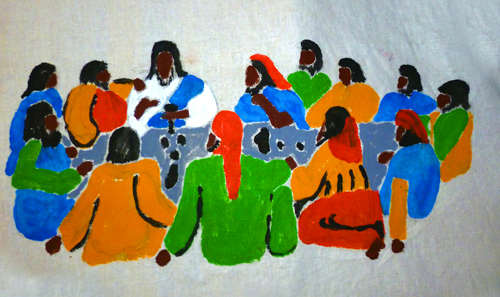
IMPACTFUL: Rupert Jack’s work depicting Abraham and Last Supper, part of ‘Easter’ by Darren Farrell. PICTURES: Supplied.
Ms Mattingley, who has long supported the work of the Bible Society noting that she believes in the importance of Aboriginal peoples having access to Scriptures in their mother tongues, says to that end, she and Ms Sherman involved Aboriginal people as much as possible during the process of creating the book. Those involved included Queensland-based artist Max Conlan who came up with the title and was also a member of the art selection committee.
As to Ms Sherman’s favourite work? She says it’s difficult to answer given that so many of the paintings spoke to her while making the book.
“I was continually surprised by the depth of theology contained in many of the paintings – for example, the painting of Pentecost by Veronica Lulu from Mulan Community in remote Western Australia is really profound in that in the top of the painting, instead of the usual trinity image (represented by three ‘U’ shapes interwoven) we see only two ‘U’ shapes representing God the Father and God the Son,” she says. “The Holy Spirit is portrayed as a dove descending on the believers. The profoundness of this imagery is the notion that Jesus sends His Holy Spirit and this distinct person of the Trinity is illustrated separated from God the Father and the Son.”
Ms Sherman says she also “found it fascinating to see the Bible Stories which the artists chose to paint” and mentions the work of Rupert Jack. A leader in his community, he chose to paint the Old Testament patriarchs Abraham and Moses.
“[S]o he obviously could relate to these strong male leaders and how God chose them to lead his people,” Ms Sherman says. “It is [also] interesting that [another artist] Kunyi [June Anne], forcibly removed from her family as a young child, chose to depict the story of Moses being sent away from his family down the Nile to be adopted and raised by Egyptian royalty. So I found it was not only the paintings that spoke to me but also the lives of the artists themselves.”
Our Mob, God’s Story is available from Koorong bookstores or the Bible Society Australia shop.





